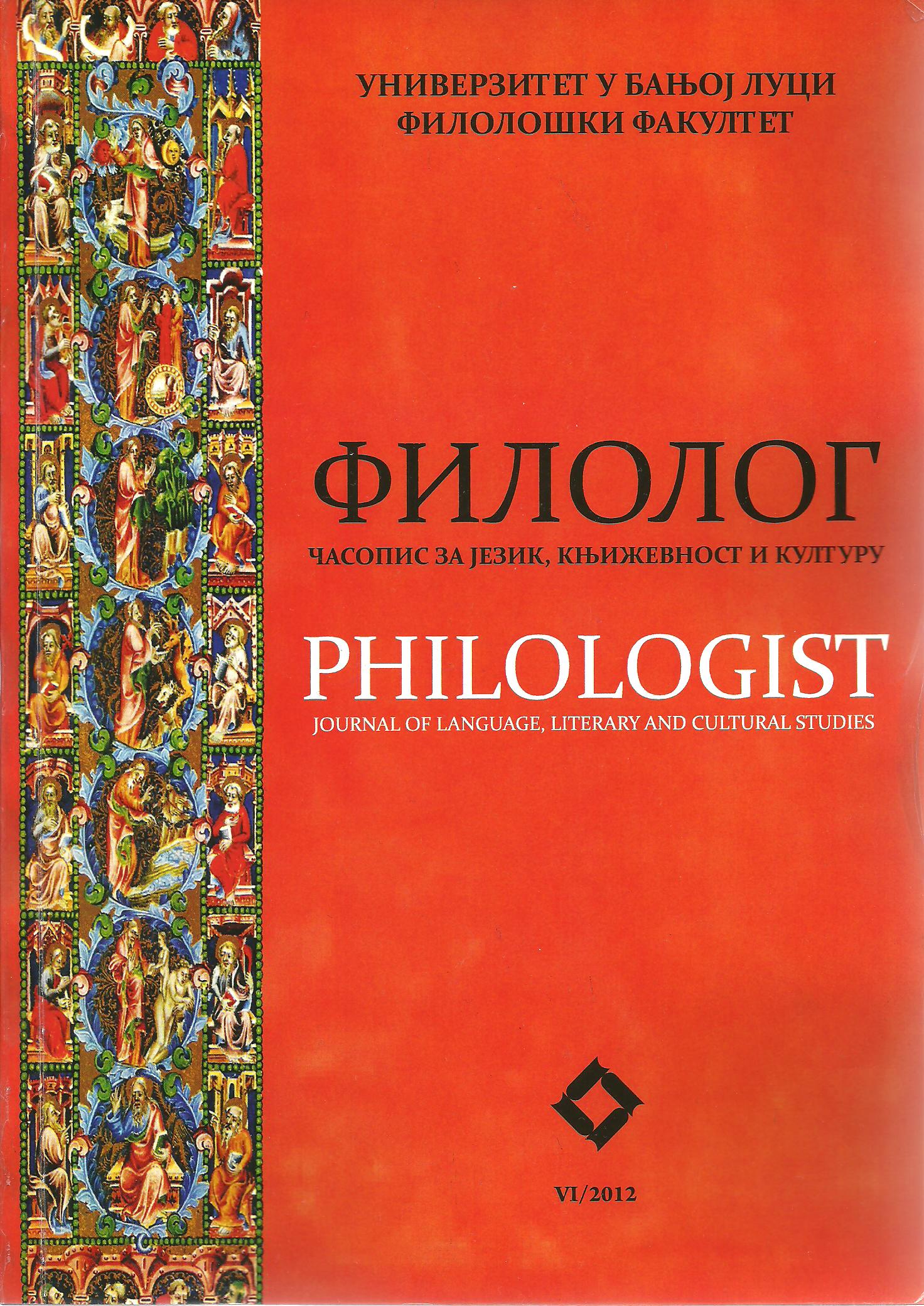
Сећање на проф. др Гордану Вуковић
Review of: Ružić, Vladislava; Pavlović, Slobodan [Eds.] (2011), Leksikologija, onomastika, sintaksa: Zbornik u čast Gordani Vuković; Novi Sad: Filozofski fakultet.
More...We kindly inform you that, as long as the subject affiliation of our 300.000+ articles is in progress, you might get unsufficient or no results on your third level or second level search. In this case, please broaden your search criteria.

Review of: Ružić, Vladislava; Pavlović, Slobodan [Eds.] (2011), Leksikologija, onomastika, sintaksa: Zbornik u čast Gordani Vuković; Novi Sad: Filozofski fakultet.
More...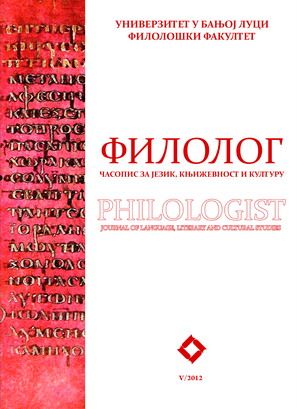
This paper is a report on the results of an inquiry into the similarities and differences between English and Serbian in terms of compound lexemes in adjectival sentential positions. The contrastive relation was established in a one-direction translation from English to Serbian, while the research was based on a specific and diversified collection of English texts and corresponding translations into Serbian. A total of 1584 examples of compound lexemes were registered in the corpus of more than one million words. The translation correspondents and equivalents in the Serbian language were analyzed in terms of their form and the function they perform in the sentence in order to determine the correlation with English counterparts. It was discovered that the formal-semantic content of the compounds in English was transferred into four structural types of equivalents, most frequently into syntagmatic structures or simple adjectives in Serbian. Also, the equivalents in the form of clause were fewer than expected.
More...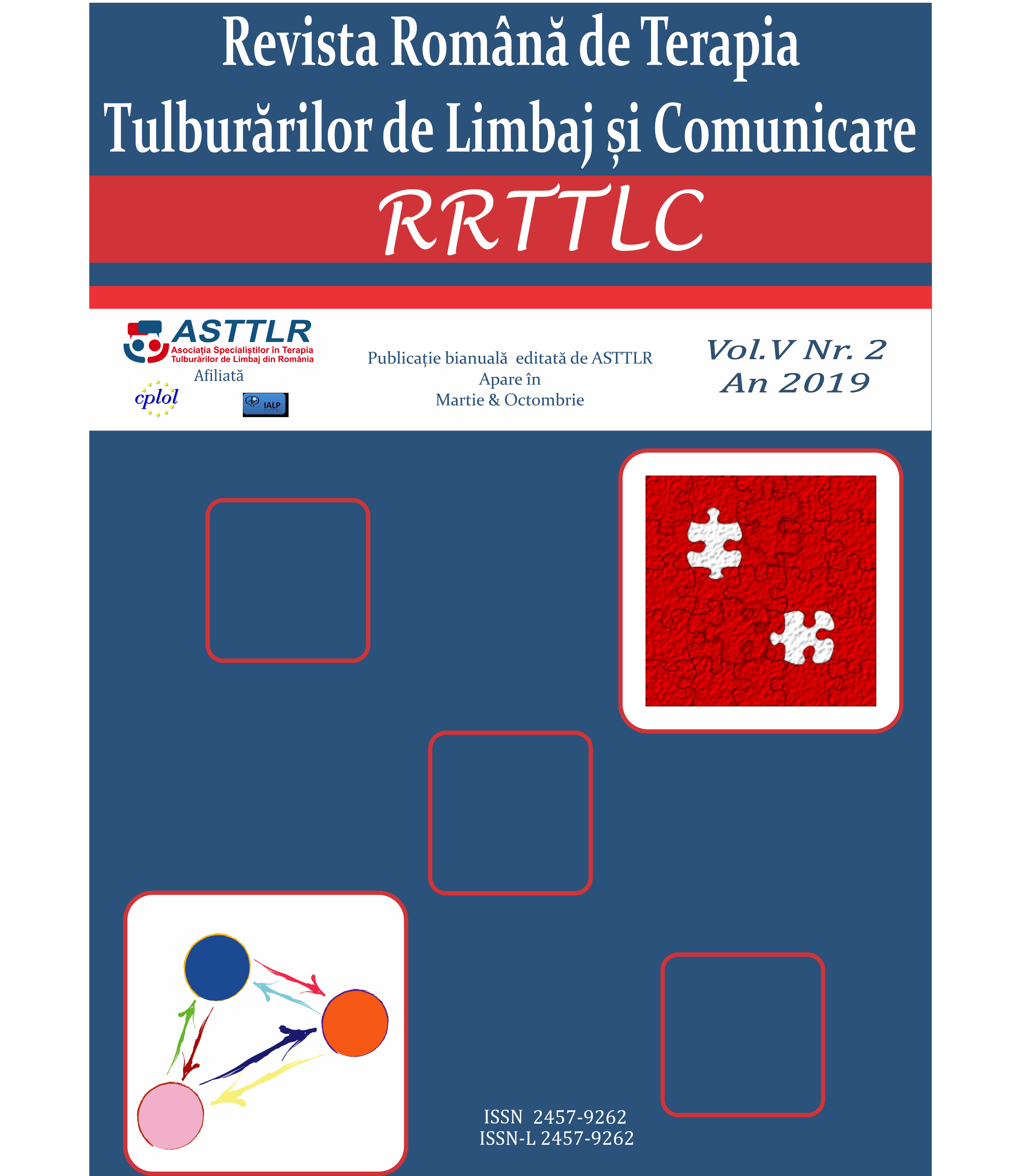
This article presents a study of quality of life for hearing impaired and deaf adolescents and emphasizes theimpact of the type of communication that they employ on different aspects of their cognitive, linguistic andsocial development. In the first part, the paper presents the theoretical framework, as well as a literaturereview of previous studies regarding quality of life for hearing impaired and deaf youth. The second partpresents the study, describing the instrument used, the method and the results. The findings of thisinvestigation reveal that hearing impaired and deaf students that learn in a boarding school setting in thespecial education system are more inclined to use sign language and to interact with their hearing impairedand deaf peers, and less willing to engage in activities with hearing people that involve verbal communication,thus diminishing their linguistic and social development
More...
Difficulties in articulation of sounds are common in speech and language therapy field. Their therapeutic approaches must be individualized The psycho-individual and age-specific features, as well as the characteristics of the type and degree of a certain disabilities, make speech therapy a unique, original, specific process.Through the present research we wanted to highlight the uniqueness of the speech therapy sessions, as we follow the classic approach, we can give a specific note to the activities carried out by innovative methods, techniques and means of teaching applied to a distinct category of pupils, those with intellectual disabilities.The research methodology include the purpose, objectives, research hypotheses, the research approach and the description of the group of participants, emphasizing the description and the usefulness of the " Paşi prin lumea sunetelor " application both as an assessment and as an intervention too The accurate identification of psycho- motricity difficulties with consequences on the language at children with intellectual disabilities integrated in compulsory general education is an important aspect which the entire process of integration depends on. It is a complex process which requires the usage of a whole set of probes which include the level of early – learning of the language and which can contribute at the creation of a whole complex portrait, with links to the psycho – motricity and communication abilities of the child, but also to the establishing of the objectives in what concerns the correction and the development of these abilities. In the first part of the article theoretical topics regarding psychomotricity, language, intellectual disability and the integration into compulsory general education of children with intellectual disability are studied , and in the second part the scientific research is presented after going through three stages: the discovery stage in which we put into practice methods with the purpose of of knowing the individual level of psycho motricity and the level of language development (four students presenting psycho motricity and language difficulties were selected ) the experimental stage which was concerned with the development of case – studies and individual action ( the process of the action was structured as a complex therapy of action, but also as some therapy – learning activities, each instrument being put into practice on every part of language regarding the development of child ‘ s abilities in the next areas: psycho motricity, language and communication, knowledge, socialization ) ; final which consisted of going again through the evaluation tasks which were applied in the discovery stage in order to underline the involvement of psycho motricity on the language and so, checking the research hypothesis.
More...
This study is an analysis of specific linguistic competences and proposes the pedagogical intervention for vocabulary developing and for lecture competences. The optimisation of lecture competences and learning abilities can be achieved by using the assessment of linguistic competences and functional and multiple literacy, using of interactive strategy and mediated learning experience. The didactics approaches of literacy and the personalised linguistic training programmes, if systematically applied, lead to a significant improvement in pupils’ school performance.
More...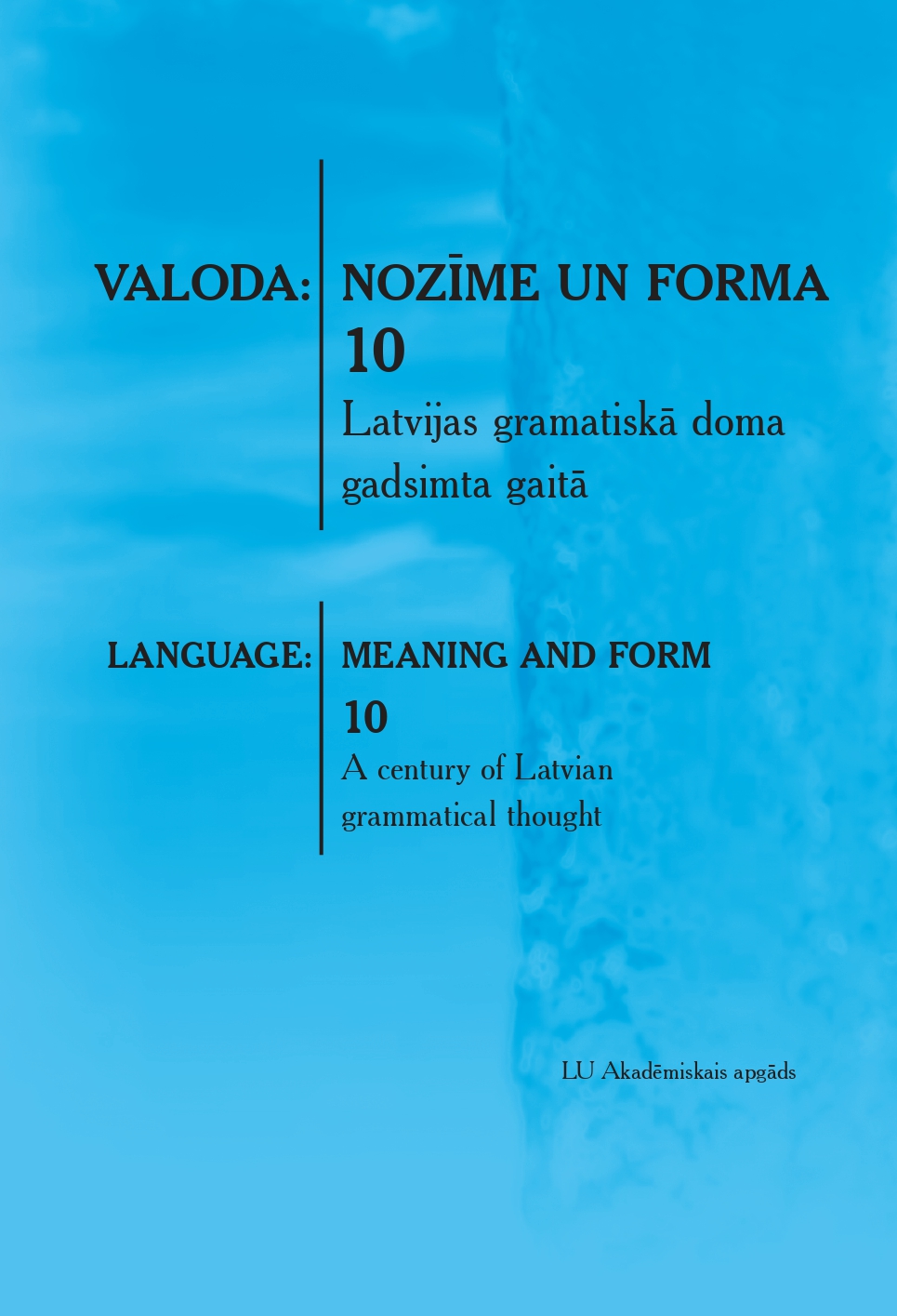
The term reflexivity names a formal feature that unites a lexical grammatical group of reflexive verbs. The aim of the research is to find out the terms used in various Latvian and Lithuanian sources, such as dictionaries, grammar books, scientific and instructional literature, to describe such verbs and verb-building. Two compound terms of different origin are popular in the works of Latvian linguistics: a three-word term of own language, atgriezeniskais darbības vārds, or a two-word term of foreign origin, refleksīvais verbs ‘reflexive verb’, (to note, endings of a secondary component can be both pronominal and non-pronominal in practice). In Lithuanian, such verbs are also called by synonymous compound terms encompassing a secondary component of different origin: sangrąžinis veiksmažodis and refleksyvinis veiksmažodis ‘reflexive verb’. The descriptions of reflexive verbs demonstrate the diversity of the terms to name the means that built them. In Latvian, atgriezeniskā galotne ‘reflexive ending’, is the most frequently used term; however, the sources display other ones, too: atgriezeniskais afikss ‘reflexive affix’, atgriezeniskais formants ‘reflexive formant, reflexive formative’, atgriezeniskā morfēma etc. In Lithuanian, this notion is named by the terms sangrąžos dalelytė ‘reflexive particle’ (cf. dalelytė in Latvian grammar terminology corresponds with a term partikula, ‘particle’) and sangrąžos afiksas ‘reflexive affix’. It was observed that the character of a formant or the position of it is emphasised in both languages, for example, in Latvian there is postpozitīvs formants ‘postpositive formant’, and in Lithuanian there is galinė morfema ‘end morpheme’, postfleksinė pozicija ‘post-flexion position’. The comparison revealed that the terms naming distribution of verbs into non-reflexive (in Latvian such verbs are called using a term tiešie ‘direct verb*’ (in the Dictionary of Latvian Terms it is given with an asterisk because it is a word-for-word translation, perhaps, there is no tradition in the English language)), and reflexive (in Latvian they are called atgriezeniskie ‘reflexive’) differed.
More...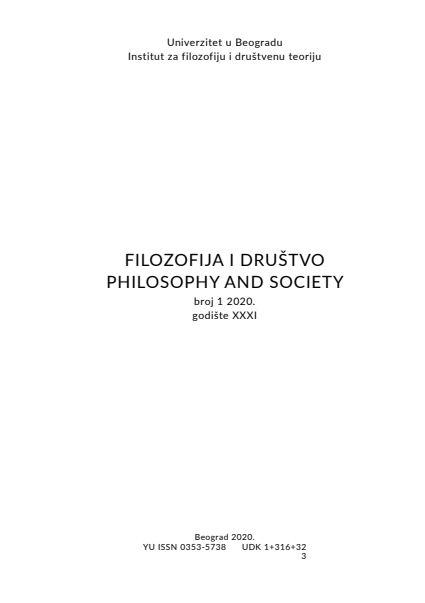
The subject of this paper is Charles Morris’ semiotic theory that has as one of its major projects the unification of all sciences of signs. However, since the above project has proven to be unsuccessful, we will try to examine here the reasons that led to this. Accordingly, we will argue that to transcend the particularities of individual disciplines that he wanted to unify, Morris had to make certain ontological assumptions, instead of theoretical and methodological ones, that they could share. However, because the ‘sign’ as an ontological category could in our view only be established if we follow the principles of the pragmatic philosophical tradition, we will try to show that the reasons for this failure should be primarily sought in different effects that consistent application of the pragmatic principles has in each of them (primarily in linguistics and the philosophy of language). On the other hand, this should enable us to draw several important conclusions regarding Morris’ project: namely, that his failure does not have to mean giving up semiotics as a potentially key discipline in approaching some fundamental philosophical problems, but also that it would demand return to the original semiotics developed in Peirce’s works.
More...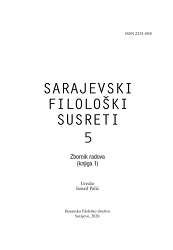
This article deals with the usage of the constructions haben + zu + infinitive and sein + zu + infinitive in legal German and the ways of translating them into the Bosnian language. These constructions are typical of legal German and the verbs haben and sein serve as modifying verbs. The formal difference between these verbs and modal verbs is the particle zu. This study seeks to determine the meaning of the verbs haben and sein (+ zu + infinitive) in the Criminal Procedure Code of the Federal Republic of Germany, and their translation equivalents in Bosnian. Modal verbs are expected to be the most commonly used translation equivalents in Bosnian; however, this research is aimed at identifying other translation equivalents, also determining their frequency. The corpus analysis shows that these constructions can be replaced with the modal verb müssen and the infinitive. The construction haben + zu + infinitive is most often translated as the present and future tense, while the construction sein + zu + infinitive is usually translated as the construction morati + se + passive and se + present tense. The constructions imati + infinitive and imati + da + present tense are also used in legal Bosnian, as suggested by the Criminal Procedure Code of Bosnia and Herzegovina. Additionally, the Bosnian language has the biti (+za) + infinitive construction, in which biti has a modal meaning. However, this construction is not characteristic of the legal language.
More...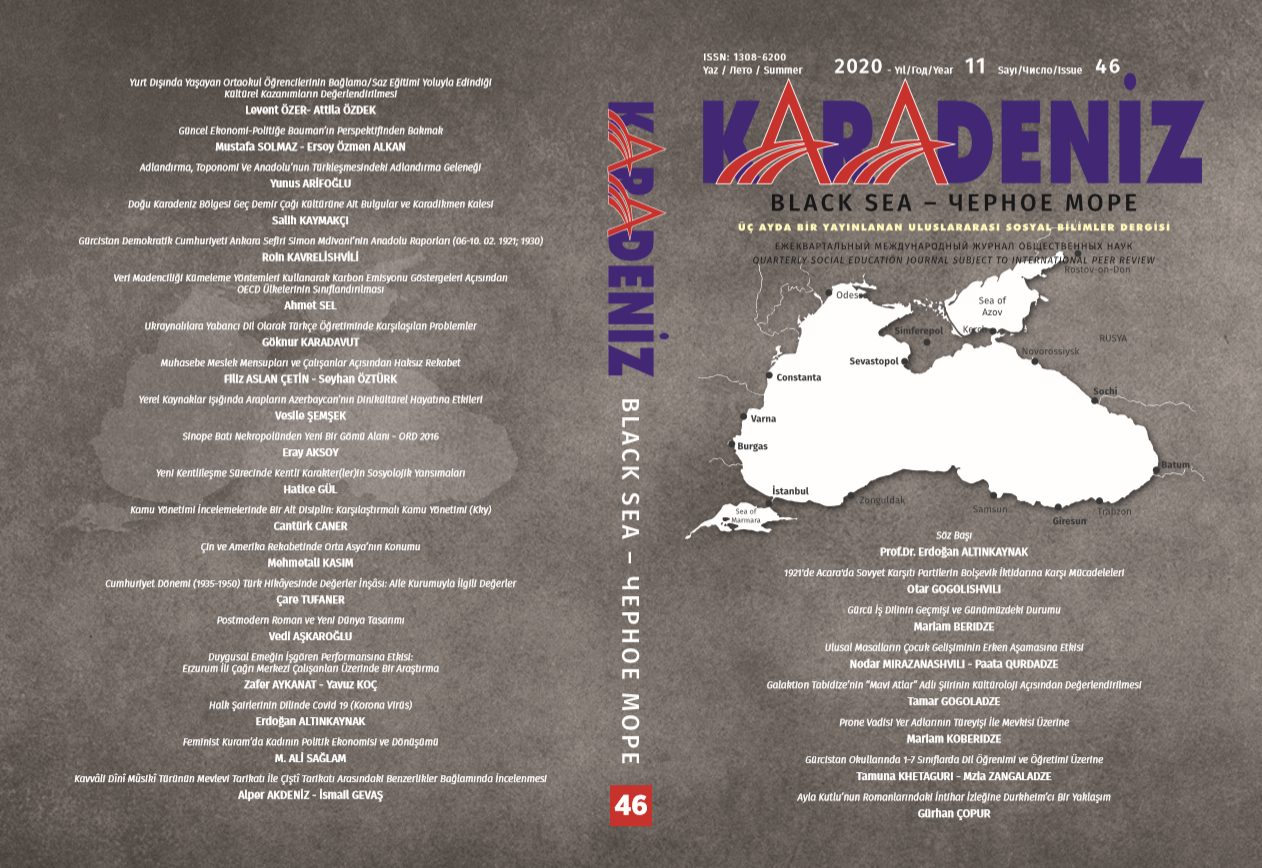
The globalizing world order has abolished official boundaries, and the mass media that have been diversifying and developing day by day have brought the communication of people of different nationalities in the World countriesto a different dimension. In addition, political, economic, scientific and cultural activities among countries have increased day by day. These two elements brought foreign language teaching to the agenda and prepared the ground work for accelerating the studies in this field. Turkish, Turkey's geopolitical and strategic position on the world, and has played an active role in World politics is thus attracted the attention of the world's countries and other nations. This has led to the teaching of Turkish as a foreign language. Turkey the country recently has become the focus of interest of the environment. From this point of view, Turkish has become one of the languages to be learned. Many students from different countries come to Turkey to learn Turkish. Some of these students belong to different language families. Therefore, there are certain problems in learning Turkish. Ukrainians occupy an important place among Turkish learning communities. These two nations, which belong to different language families, have difficulties in learning the target language. At the beginning of the problems encountered in teaching Turkish as a foreign language to the Ukrainians, which are the subject of the study, we see that the problems related to the sound transmission of Turkish, the problems in terms of morphology, the problems in terms of sentence formation and the problems related to meaning. The study was carried out with qualitative research method on thirty-eight students learning Turkish at Akdeniz University Tömer and Gazi University Tömer. In this study, the above mentioned structural differences, the problems of individuals caused by these differences are discussed, their mistakes are examined and suggestions are made and it is aimed to make Turkish education as a foreign language effective for Ukrainians.
More...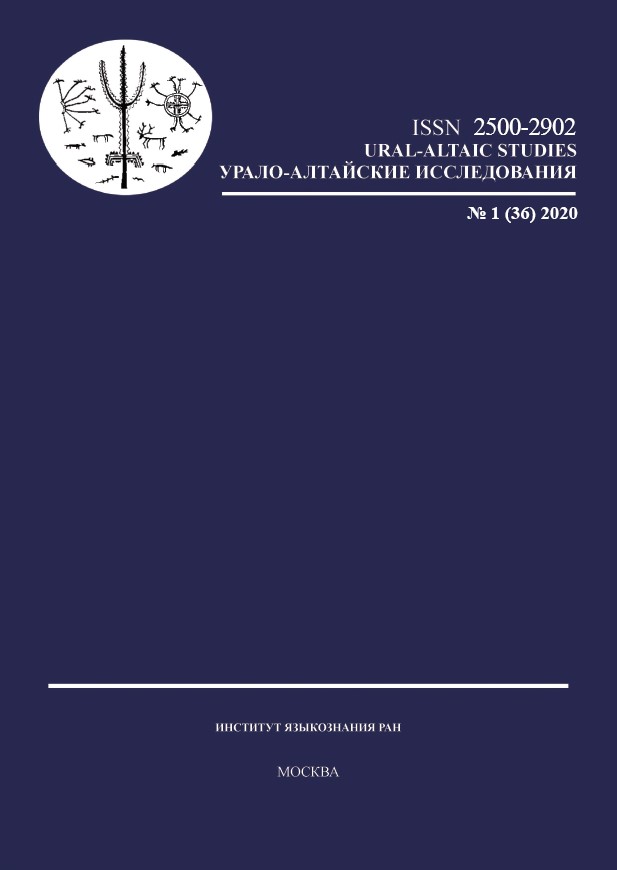
Review of: Vadim V. Dyachkov - Рецензия на книгу: Элементы татарского языка в типологическом освещении. Мишарский диалект Ред. С. Г. Татевосов, А. Г. Пазельская, Д. Ш. Сулейманов. — М.: «Буки Веди», 2017. xxviii + 761 с. ISBN 978-5-4465-1693-3. / ELEMENTY TATARSKOGO YAZYKA V TIPOLOGICHESKOM OSVESHCHENII [ELEMENTS OF THE TATAR LANGUAGE IN A TYPOLOGICAL PERSPECTIVE] (MOSCOW, 2017. XXVIII + 761 PAGES)
More...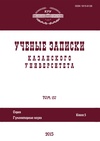
The paper provides a detailed analysis of the features of the title of V.V. Nabokov’s story “Tyrants Destroyed” as an example of the iconic sign in the light of the theory of language-game poetics. The study is highly relevant, because it offers a new way to describe the features of the title text based on language game. By considering the title as an iconic sign we focused on its semantic, syntactic, and pragmatic features. The title of the story under study is as an autosemantic element and an iconic sign that will be deciphered in the text, but carries important prior information. To describe the peculiarities of the title, we used the theory introduced by Ch. Morris on the triple essence of the sign. According to this theory, the title was considered as an iconic sign: its semantics, syntactics, and pragmatics were described. The semantic and syntactic analysis of the title revealed its bipolar structure, which is generally expressed as “counteraction to action”. With the help of the pragmatic analysis, the role of inclusions in the text in the form of multiple repetition of the name Hamlet was determined. Based on the data obtained by the semantic and syntactic analysis, we concluded that the allusion emphasizes the playful nature of the text and refers to the title, which acquires an additional connotation. The introduction of the precedent name Hamlet not only helps to decode the semantic content of the title, but also reveals V.V. Nabokov’s critical point of view on another text – the tragedy of “Hamlet” by W. Shakespeare.
More...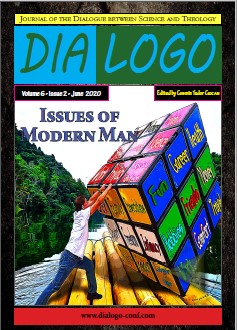
This paper is presenting a precise contextual methodology to teach and learn in a transdisciplinary way, the very current message from the Gospels through the Parables, and explicitly the parable of the Sower. The method used is the generative synergistic way to integrate the knowledge in a tree of knowledge profile using five levels of representation of reality, statistics-measuring, syntax-absorbing by codes, semantics filtering by the selection, pragmatics-interacting by teaching/learning, and apobetics innovating, in order to attain the Expertise as wisdom (top-down) and skills (bottom-up), the final goal being the Truth. A critical aspect of transdisciplinary teaching/learning is the use of the creative expression to engage the learner using their outer senses of sight, sound, taste, touch, and smell, as well as their inner senses of imagination, intuition, and impulse. In the parable of the Sower, an exceptionally special story is set up where the Sender, Jesus Christ, describes the individuals within the context of the story through heart attitudes and actions stemming from their will. The listener or reader of the parable, as receivers of the synergistic contextual message, is drawn into the story and identifies immediately with the character that describes their heart attitude. It is also a predictor of what decision they will make and what road they will take – accepting the Truth and walking in obedience or rejecting the Truth and following after their own heart’s desire. The purpose of telling the parable is two-fold. First, for those who have ears to hear, it means to reveal the meaning and receive the message, which is Himself (the Sender of the message) and understand His Kingdom, as the place where the knowledge is attained in its highest form and in the deepest way through communion. Secondly, for those who do not have ears to hear, the meaning will remain concealed, exposing their lack of belief.
More...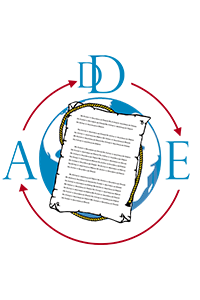
Culture and vocabulary are among the fundamental elements of the identity of a language. The culture reflects itself in the nature of the words, and therefore in the language. The changes in the vocabulary of a language display themselves in the culture in return. An investigation into these reflections can yield valuable insights regarding changes in a language over time as well as the syntactic features of a language and cultural values. Vocabulary of a language encompasses many linguistic elements such as proverbs, idioms, reduplications. These elements reveal themselves most vividly in spoken and written cultural productions. Analyzing these lexical units in literary works written both for children and adults may allow us identify the level and structure of the language, the use of lexical elements, and cultural values. To this end, this particular study aims to examine the idioms employed in the stories by Sevim Ak as well as analyze their semantic values for the text. For the analyses of the lexical elements, idioms were specifically chosen because they are widely used both in daily life and other areas and they suggest clues for linguistic and cultural elements. This study is a descriptive study in which 19 stories by Sevim Ak and idioms used in these stories were found. The findings revealed that the author utilized idioms to a great extent, therefore, contributed to its originality and semantic richness. Moreover, they were found to be useful in developing children's vocabulary knowledge and enhance their conceptual understanding.
More...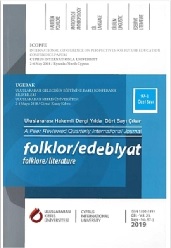
Given the undeniable influence of effective language teachers on successful language teaching and learning practices, this study was set out to address the attributes of effective language teachers based on Libyan university level student teachers’ perception. A multi-method approach including both qualitative and quantitative means of data collection was employed in the study. Results indicated that Libyan student teachers placed high importance on 1) Knowledge and credibility including possessing the knowledge of grammar and vocabulary; 2) Delivery principally by encouraging student participation and increasing students’ self-confidence; 3) Fairness as mainly characterized by teacher impartiality; 4) Rapport specifically through features that involved care and attention students; and 5) Organization and Preparation as manifested by prior preparation for every lesson and provision of supplemental material by teachers. The findings have important implications for student teachers and language teachers to improve the efficiency of their teaching practices.
More...
The present study applies a checklist of linguistic and stylistic categories developed by Leech and Short (2007) to examine the short story “Eleven” written by Sandra Cisneros. Stylistic analysis is the study that examines the level of efficacy in the utility of words or language in a sentence or any writing. In this sense, this study is concerned to provide stylistic analysis of the selected short story concerning its underlying theories from a method of prose text analysis that affianced by literary stylists Leech & Short (1981) to be able to determine its stylistic efficacy concerning lexical category. This study provides awareness in developing and presenting a model for EFL teachers how to use this kind of analysis in EFL context. In this regard, as the analysis is made up the aspects of lexical pattern, it would be prominently crucial in understanding the importance of how to select literary texts for language learners to be able to promote language learning. Thus, this study is useful and worthy endeavor in foreign language teaching as it sheds light in the awareness of selecting appropriate literary texts depending on students’ needs, interest and levels for not creating dilemma in learning process and demotivating learners, and clarifying to what extent pedagogical stylistics provide contribution to learning foreign language.
More...
The aim of this paper is to investigate Iranian email invitations production considering the gender, the distance between the inviter and the invitee, and the representation as independent variables. To this end, 30 EFL learners including 15 males and 15 females at intermediate level were designated to write email invitations in two different situations. Totally, 60 invitation emails were collected and analyzed. The findings, regarding the length of speech prior to the invitation sentence (s), showed that Iranian EFL learners produced words before the main invitation sentence specifically when they know the invitee. For information sequencing, the frequency of [supportive+invitation] was high among males and females; that is Iranians put their invitation after the supportive sentences to enhance their positive face and the invitee’s. With regard to verb usage in email invitations, Iranian EFL learners used ‘want’, ‘invite’ and ‘would like to invite’, mostly the last two (invite/would like to invite).
More...
Despite a general tendency to avoid L1 use in the L2 classroom, pedagogical research has recently begun to challenge the predominantly monolingual approach to L2 teaching, and reassign the role of the L1 as a useful tool for both instructors and learners (Cook, 2001; Levine, 2011; Turball & Dailey O’Cain, 2009). However, while it is evident from previous research that the L1 serves several functions in the L2 classroom - and perhaps has an unavoidable presence that should be acknowledged - few studies look at how L1 use can positively impact L2 learners' classroom experiences and learning outcomes. The present study looks at instructor L1 use as it relates to learners’ perceptions of their learning, as well as actual outcomes in terms of grammatical competence. Using data collected from a pilot study as well as an expanded follow-up study, this article aims to investigate the use of the L1 (English) in the L2 (Spanish) classroom in terms of instructor use and its relation to learners’ perceived competence in L2 grammar. Results from both studies conform to previous findings in terms of the contexts in which the L1 is used by instructors. Furthermore, these results suggest that the L1 plays an important role in facilitating communication and establishing a rapport between instructors and learners, and through this may also positively impact learners' confidence and perceived competence in L2 grammar.
More...
The review of: Susanne Niemeier, Task-based Grammar Teaching of English: Where Cognitive and task-based language teaching meet, Narr Dr. Gunter; 2017, 246pp; ISBN: 978-3823381303.
More...
This current study aims to shed a new light into the usage of phrasal verbs, which are one of the most avoided multi-word constructions for English learners but widely used by native speakers of English in BASE (British Academic Spoken English). The purpose of this study is to identify which phrasal verbs are used more frequently in BASE and how the findings might be utilized in educational settings. To do this, three lexical verbs (go, come and take) combining phrasal verbs with nine adverbial particles and forming 27 phrasal verbs were analysed using 1.742.886 running words in BASE. BNC (British National Corpus) was used as the core data for selecting lexical verbs and adverbial particles by benefiting from the research of Gardner and Davies (2007). The results reveal some similarities between BNC and BASE in terms of phrasal verb usage and the paper exemplifies some ways to teach phrasal verbs in the light of the analyses.
More...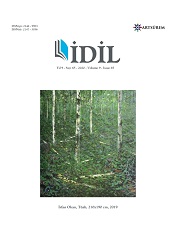
Linguistic borrowing is the name given to language elements taken from a foreign language that more or less constitute the mother tongue. The most important element that sets the stage for borrowing, which means word exchange in a sense, the increasing relationship level of different cultures can be shown. This increase is undoubtedly based on technological developments, internet and films. In addition, international commercial, economic, scientific, cultural and political contacts, geographical location, historical events, wars and changes in social life are among the factors that create a favorable occasion for borrowing. Borrowed words, terms, expressions of foreign origin are available in all languages in the world. It is known that hundreds of thousands of words in the current vocabulary of Polish come from other languages. The other part consists of words from old Polish language, words derived from Slavic roots or borrowed words from the other languages. These words can penetrate into Polish in two ways: through direct contact (direct borrowings) and through another language (indirect borrowings). Borrowing can occur not only on the basis of words, but also within the framework of idioms, phrases, structures, or affixes. Some of them have entered without any change, while others have been modified and adapted to the Polish word and grammar structure. However, some of the structures in Polish modelled on foreign language today are not considered correct by some linguists. In this study, it will be examined how many types of borrowing there are, the ways in which it is realized and which structures are considered as wrong.
More...